Fossil is the mark or remains of an organism that lived thousands or millions of years ago. Some of the best-known fossils include leaves, shells, or skeletons that were preserved after a plant or animal died. Others include tracks, trails, or burrows left by moving animals.
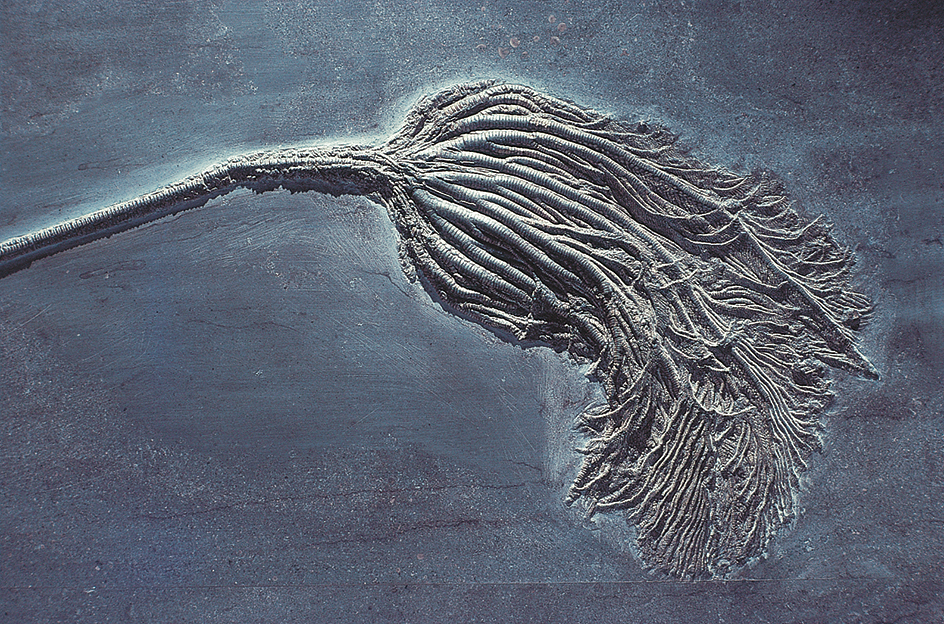
Most fossils occur in sedimentary rocks. Such fossils formed from plant or animal remains that were quickly buried in sediments—the mud or sand that collects at the bottom of rivers, lakes, swamps, and oceans. Over time, these sediments became buried under other sediments. The upper sediments pressed down on the layers of mud and squeezed them into compact rock layers. Water that traveled slowly through the layers of sand deposited mineral cement around these particles, cementing the layers together to form rocks (see Sedimentary rock).
Loading the player...Fossil formation
A few fossils formed in other ways. For example, whole plants or animals became preserved in ice, tar, or hardened sap.
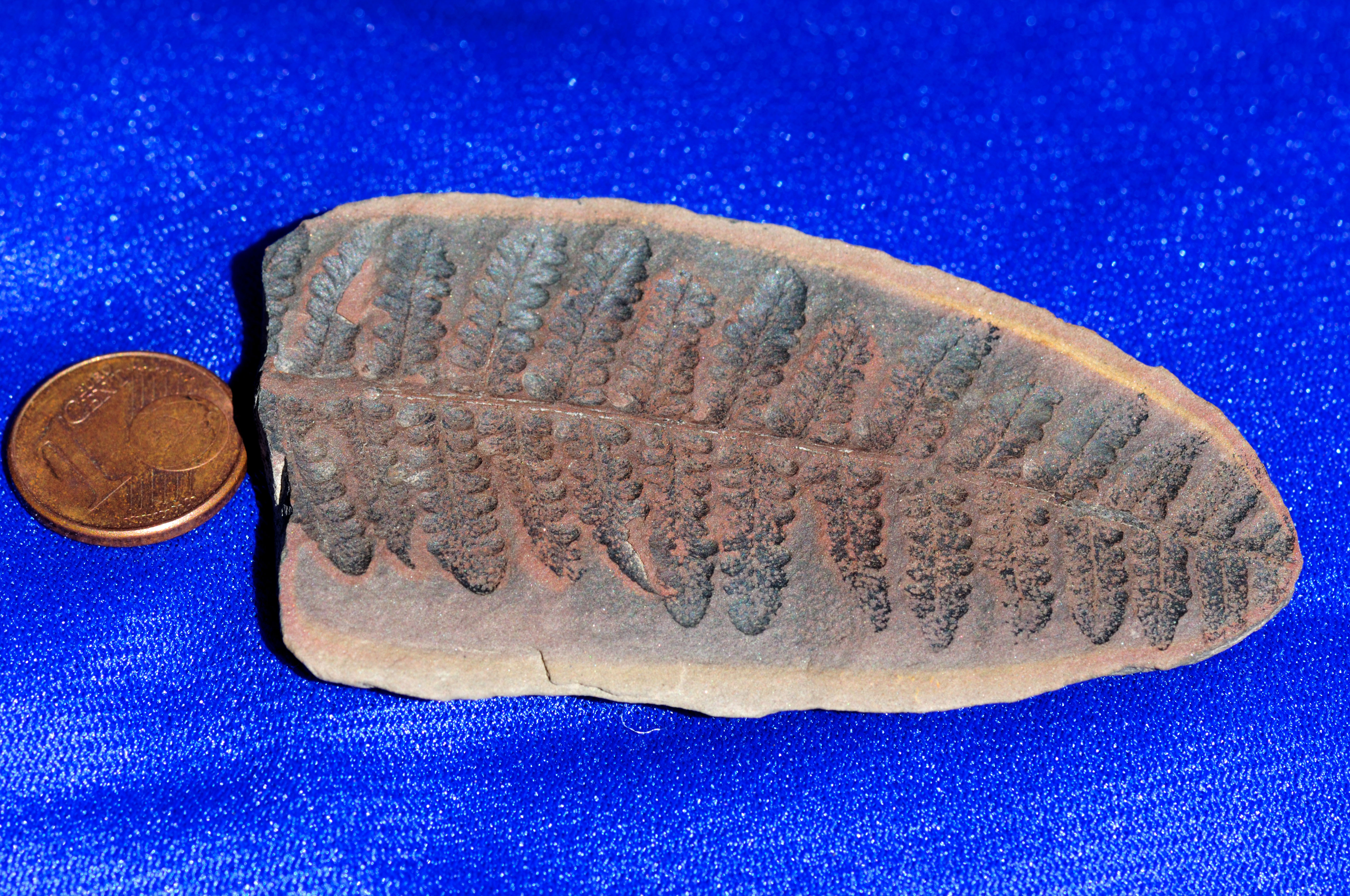
The oldest fossils are microscopic traces of bacteria that probably lived about 31/2 billion years ago. The oldest animal fossils are remains of invertebrates (animals without a backbone) about 650 million years old. The oldest fossils of vertebrates (animals with a backbone) are fossil fish more than 450 million years old.
Fossils occur more commonly than many people realize. Even so, only a small portion of the countless organisms that have lived on Earth have been preserved as fossils. Many species (kinds) of organisms lived and died without leaving any trace in the fossil record.
Although the fossil record is incomplete, many important groups of organisms have left fossil remains. These fossils help scientists discover what forms of life existed at various periods in the past and how these prehistoric species lived. Fossils also indicate how life on Earth has gradually changed over time. This article explains how fossils provide information on ancient life. For a description of ancient animals, see Prehistoric animal; for a description of early human beings, see Prehistoric people.
How fossils reveal the past
In the distant past, when most fossils formed, the world was different from today. Plants and animals that have long since vanished inhabited the waters and land. A region now elevated to form high mountains may have been the floor of an ancient sea. Where a lush tropical forest thrived millions of years ago, there may now be a cool, dry plain. Even the continents have drifted far from the positions they occupied hundreds of millions of years ago. No human beings were present to record these changes. But paleontologists (scientists who study prehistoric life) have pieced together much of the story of Earth’s past by examining its fossil record.
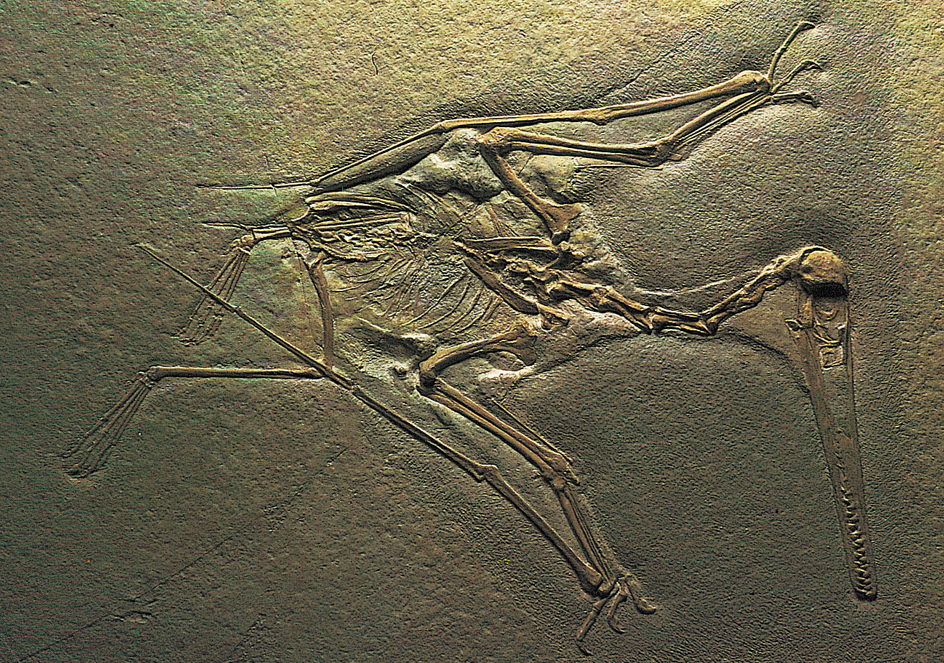
Understanding ancient plants and animals.
By studying fossils, paleontologists can learn much about the appearance and ways of life of prehistoric organisms. One way scientists learn about a fossil animal or plant is by comparing it to living species. In many cases the comparisons show that the fossil species has close living relatives. Similarities and differences between the fossil species and its living relatives can provide important information. For example, according to anthropologists, fossils show that Homo erectus—a species that lived from about 1.8 million years ago to about 300,000 years ago—was an ancient ancestor of physically modern human beings. Its fossilized pelvis, leg, and foot bones are similar in structure to modern human bones. Paleontologists know that modern human bones are designed for walking upright. From this evidence, they have determined that Homo erectus also walked upright (see Homo erectus).
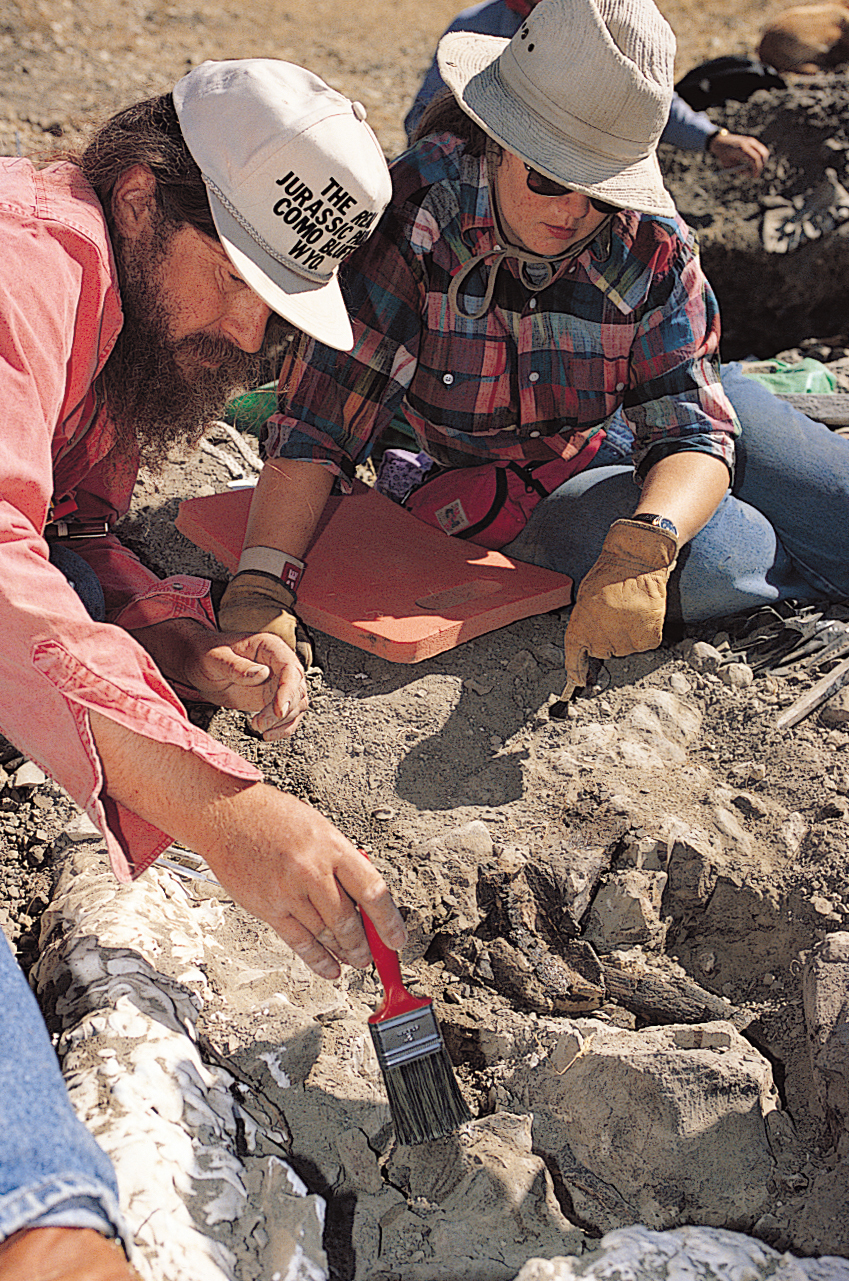
Fossil plants and animals that do not have close living relatives prove more difficult to understand. One way to learn how they lived is to compare their fossils to unrelated living species that have similarly shaped structures. For example, fossils show that about 240 million to 65 million years ago there lived a group of reptiles with one long, slender finger extending from each front limb. This bone structure does not resemble that of any living reptile. It appears, however, similar to the wings of modern birds and bats. Since modern birds and bats use their wings for flying, paleontologists conclude that these ancient creatures also flew. Paleontologists call them pterosaurs, which means winged lizards.
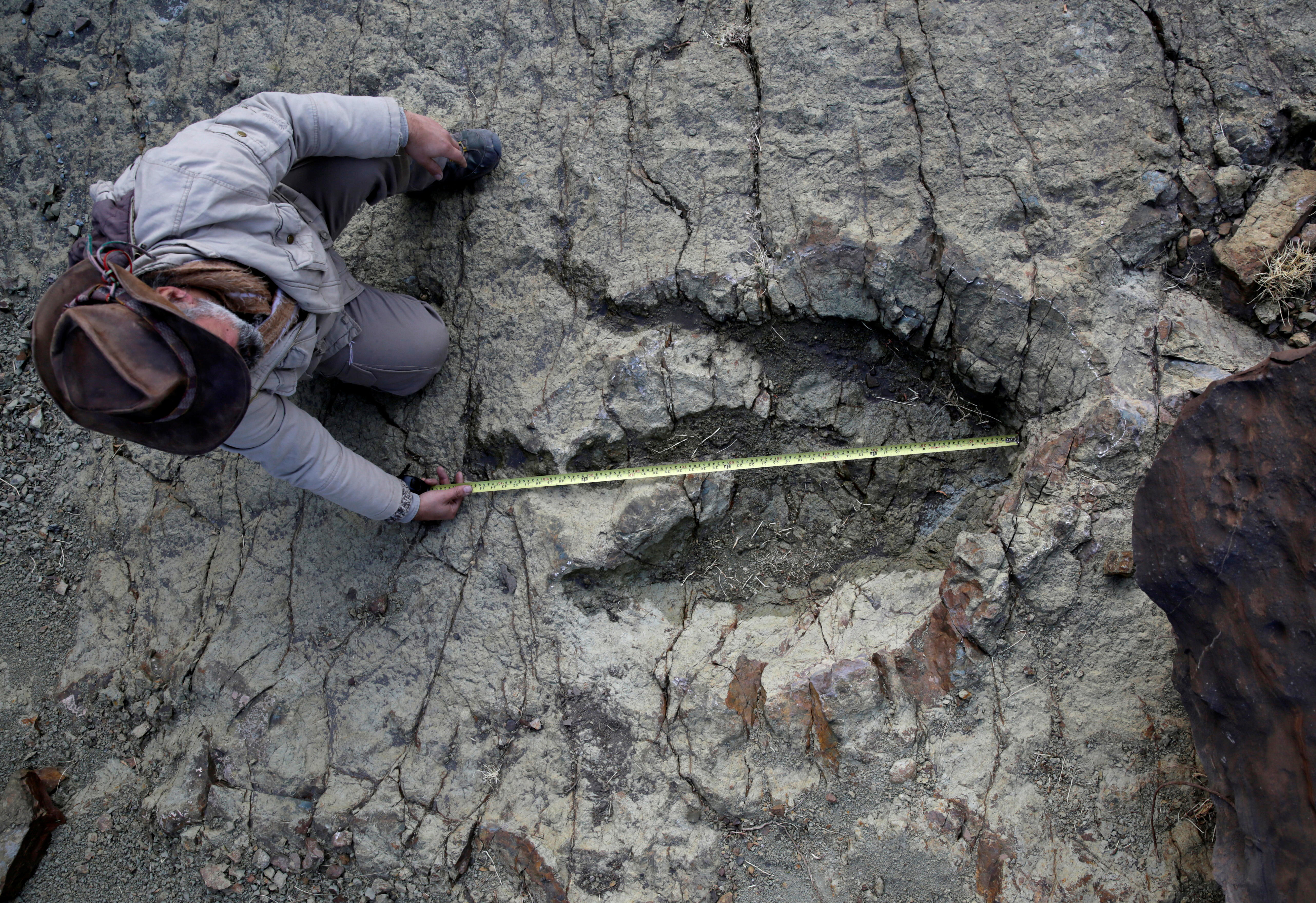
The conditions under which fossil creatures died can also reveal how they lived. Paleontologists have found fossil nests of partially grown baby dinosaurs. These fossils indicate certain species of dinosaurs fed and cared for their young in nests, much as today’s birds do.
Fossils of tracks, trails, or burrows—called trace fossils—provide information on the behavior of prehistoric animals. Groups of dinosaur tracks, for example, suggest that some species of dinosaurs traveled in herds. Other trace fossils show that primitive worms lived in simple tubes dug in the sea floor.
Tracing the development of life.
The fossil record provides important evidence of the history of life. Fossils indicate that over hundreds of millions of years life on Earth has evolved (developed gradually) from simple, one-celled bacteria and algae into a tremendous variety of complex organisms. Fossils also indicate that certain species changed dramatically, giving rise to entirely new forms of life.
The location of fossils in the strata (layers) of sedimentary rock can show how living things increased in complexity through time. As sediment was deposited, new layers settled on top of older ones. When the sediment turned to stone, these layers were preserved in the order in which they were laid down. In undisturbed strata, fossils in the lower—and thus older—layers are more primitive than those in younger strata nearer the surface.
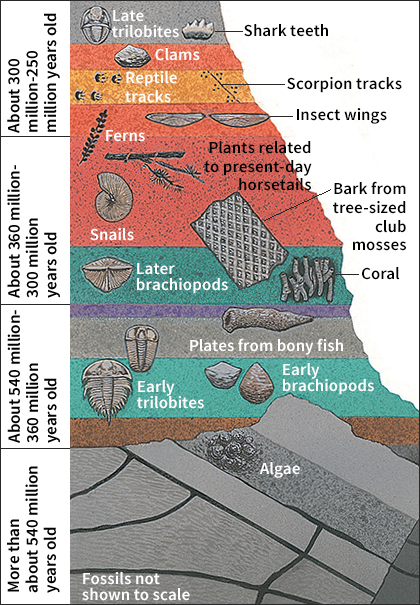
The fossils preserved in the strata of the Grand Canyon in Arizona provide a good example of the increasing complexity of living things. Strata near the bottom are about 1 billion years old and contain only primitive fossil algae. Strata dating from about 500 million years ago contain fossils of invertebrates, including those of extinct sea animals called trilobites. Remains of fish first appear in strata about 400 million years old. Some of the upper strata, which formed between 330 million and 260 million years ago, contain tracks of the first land animals.
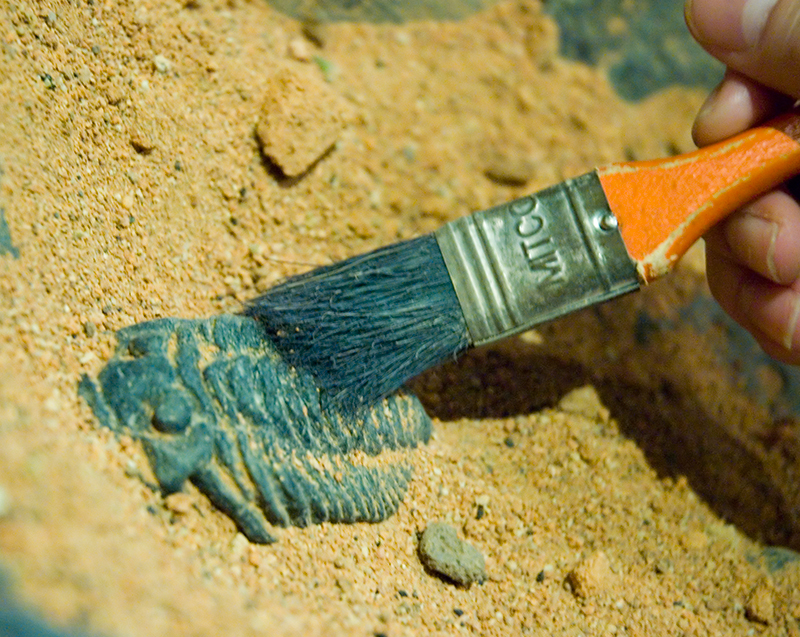
Certain fossils indicate that particular groups of plants or animals evolved from others. These transition fossils combine characteristics of two major groups. For example, fossil skeletons of Ichthyostega, a creature that lived about 360 million years ago, provide evidence that tetrapods (four-legged animals) evolved from fish. Ichthyostega had legs, enabling it to live on land. Ichthyostega‘s leg bones, however, were similar to the fin bones of fish. It also had fishlike teeth and a broad, finned tail for swimming. Fossils indicate that later tetrapods lost these fishlike traits and became better adapted to life on land.
Fossils also show how groups of plants and animals became more diverse after they originated. Fossil leaves and pollen grains of the first flowering plants date from the early Cretaceous Period, sometime after 138 million years ago. These fossils record only a small number of species. Fossils from later in the Cretaceous, about 90 million years ago, include a wide variety of flowering plants from many different environments.
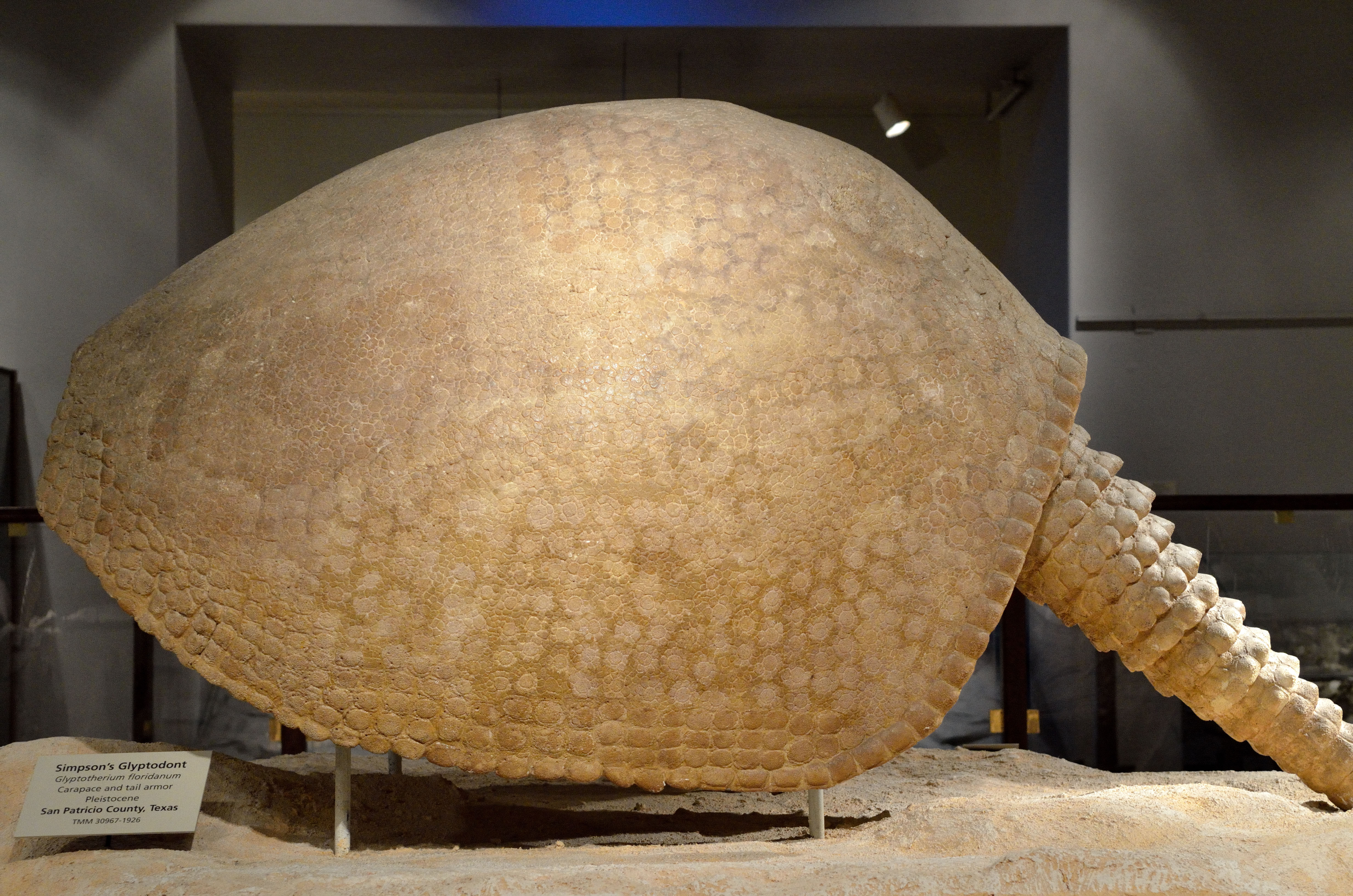
Recording Earth’s changes.
Paleontologists use fossils to determine how Earth’s climate and landscape have changed over millions of years. For instance, they have found fossils of tropical palm trees in Wyoming, an area that has a cool climate today. These fossils indicate that the climate in that area has cooled. Paleontologists have found fossil oysters in Kansas and other areas that lie far inland today. Such fossils reveal that a shallow sea once spread over these areas.
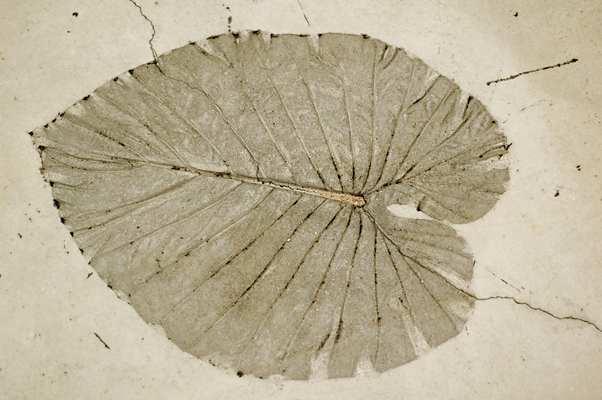

Fossils also provide evidence supporting the theory of continental drift—the idea that the positions of the continents have changed over hundreds of millions of years. Paleontologists have found similar kinds of fossil dinosaurs on all of the modern continents. These similar species could not have evolved on separate continents. Because of such evidence, Earth scientists now recognize that when dinosaurs first appeared—about 230 million years ago—nearly all of Earth’s land mass was united as a single supercontinent. In contrast, fossils of mammals show complex differences from continent to continent. Thus scientists know that, by the time the Age of Mammals began about 65 million years ago, Earth’s land mass had divided into many continents. See Plate tectonics .
How fossils form
The great majority of plants and animals die and decay without leaving any trace in the fossil record. Bacteria and other microorganisms break down such soft tissues as leaves or flesh. As a result, these tissues rarely leave fossil records. Even most hard parts, such as bones, teeth, shells, or wood, are eventually worn away by moving water or dissolved by chemicals. But when plant or animal remains have been buried in sediment, they may become fossilized. These remains are occasionally preserved without much change. Most, however, become altered after burial. Many disappear completely, but still leave a fossil record in the sediment.
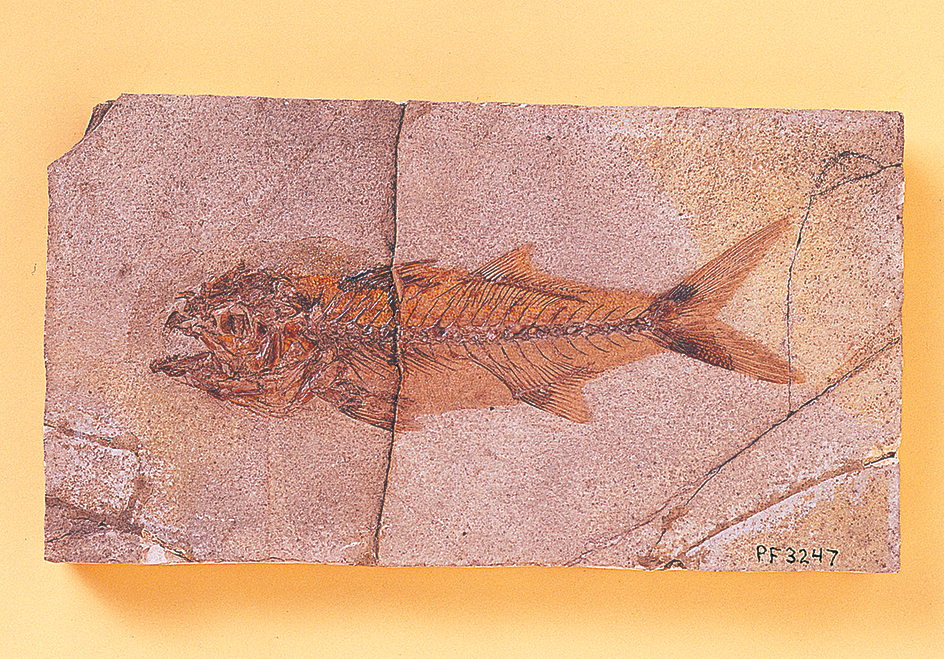
Fossils may be preserved in several ways. The main ways are (1) the formation of impressions, molds, and casts; (2) carbonization; and (3) the action of minerals.
Formation of impressions, molds, and casts.
Some fossils consist of the preserved form or outline of animal or plant remains. Impressions, also called prints or imprints, are shallow fossil depressions in rock. They form when thin plant or animal parts become buried in sediment and then decay. After the sediment has turned to stone, only the outline of the plant or animal remains preserved. Many impressions consist of small grooves left by the bones of fish or the thick-walled veins found inside leaves. Sometimes even delicate soft parts, such as feathers or leaves, are preserved as impressions.

Molds form after hard parts become buried in mud, clay, or other material that turns to stone. Later, water dissolves the buried hard part, leaving a mold—a hollow space in the shape of the original hard part—inside the rock. A cast forms when water containing dissolved minerals and other fine particles later drains through a mold. The water deposits these substances, which eventually fill the mold, forming a copy of the original hard part. Many seashells are preserved as molds or casts.
Carbonization
results when decaying tissues leave behind traces of carbon. Living tissues consist of compounds of carbon and other chemical elements. As decaying tissues break down into their chemical parts, most of the chemicals disappear. In carbonization, a thin, black film of carbon remains in the shape of the organism. Plants, fish, and soft-bodied creatures have been preserved in precise detail by carbonization.
The action of minerals.
Many plants and animals became fossilized after water that contained minerals soaked into the pores of the original hard parts. This action is called petrifaction. In many such fossils, some or all of the original material remains, but it has been strengthened and preserved by the minerals. This process is called permineralization. The huge tree trunks in petrified forests were preserved by permineralization.
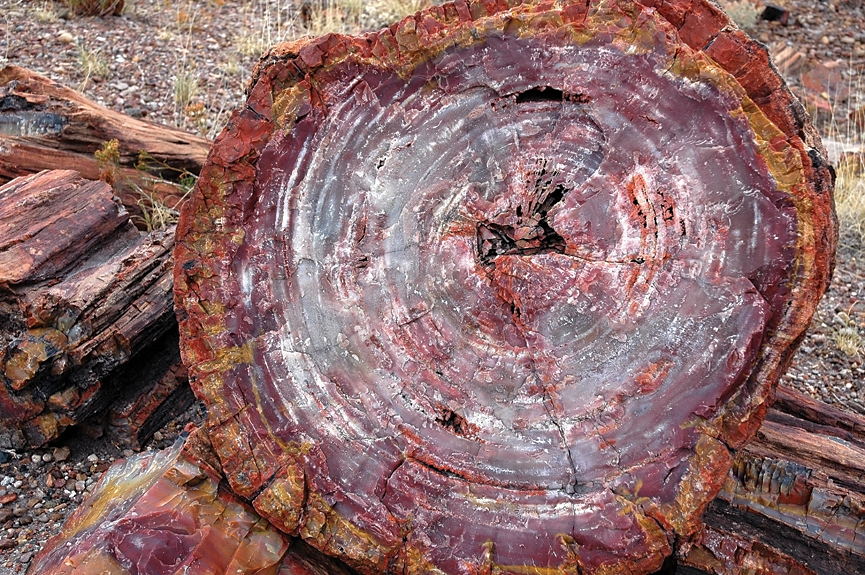
In other cases, the minerals in the water totally replaced the original plant or animal part. This process, called replacement, involves two events that happen at the same time: The water dissolves the compounds that make up the original material, while the minerals are deposited in their place. Replacement can duplicate even microscopic details of the original hard part.
Other processes.
Occasionally, animal and plant structures are fossilized with little or no change. In mummification, an animal’s skin and other tissues are preserved by drying or by the action of chemicals. Mummification may occur when a dead animal is buried in a dry place, such as a desert, or in asphalt or some other oily substance.
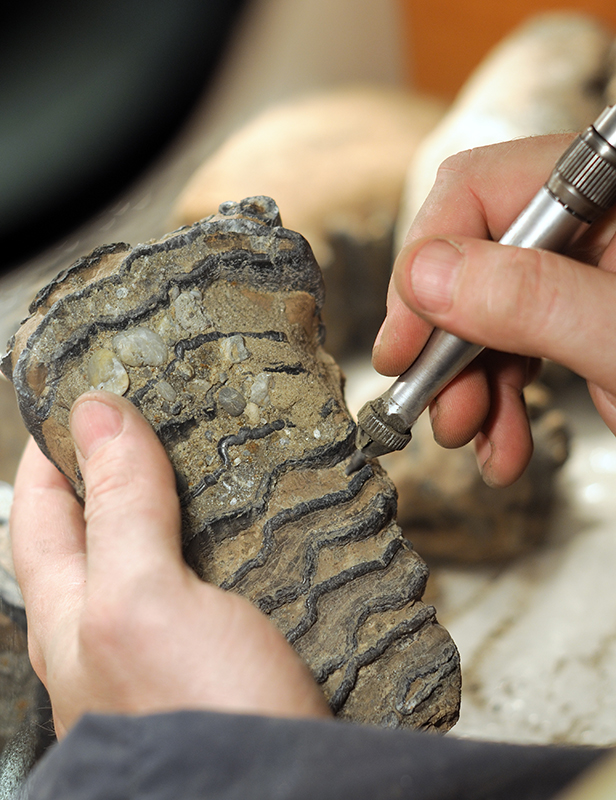
Some processes fossilize whole animals. Insects sometimes are preserved whole in amber, the hardened sap of ancient pines or other trees. Such insects were trapped in the sticky sap and then sealed when it turned to amber. In Alaska and in Siberia, a region in northern Asia, woolly mammoths thousands of years old have survived frozen in the ground. Their hair, skin, flesh, and internal organs have been preserved as they were when the mammoths died. Food preserved in their stomachs even reveals what they ate.
Studying fossils
Discovering fossils.
Fossils can occur wherever sedimentary rocks lie exposed. In moist regions, these rocks are usually buried under a layer of soil and plant life, but they become exposed by water erosion along the sides of river valleys. Sedimentary layers also become uncovered during highway construction and other building projects. In deserts and other arid regions, erosion exposes sedimentary rocks over broad areas. And oil-well drilling often brings up fossil-bearing sedimentary rocks from deep under the ground.

Paleontologists search in specific areas for particular types of fossils. For example, Mongolia provides a rich source of dinosaur fossils. Paleontologists hunt for fossil ancestors of human beings in eastern and southern Africa. All continents have numerous deposits containing well-preserved ancient marine invertebrates and microscopic organisms.
Collecting fossils.
Different fossils require different collecting techniques. Fossils of shells, teeth, and bones preserved in soft sand or mud prove easiest to collect. Paleontologists can dig out these fossils with a trowel or shovel or remove them by hand. They also can use a sieve (strainer) to remove small fossils from the sediment. Fossils preserved in hard rock are most easily found and collected when they have become exposed by natural weathering. Weathering refers to the chemical and physical processes that break down rock at Earth’s surface. Fossils that are more resistant to weathering than the surrounding rocks stand out on exposed rocky surfaces. Most such fossils can be collected by breaking loose the rock with a chisel, hammer, or pick. Paleontologists also expose and collect fossils that are hidden in solid rock by breaking the rock with a sledge hammer or a hammer and chisel. Rocks containing fossils often break along the surfaces of the fossils.

Scientists must protect fragile fossils before breaking them out of the rock. Paleontologists wrap the exposed parts of such fossils in layers of cloth soaked with wet plaster. After the plaster hardens, the fossils can be safely chipped from the rock and transported to a laboratory, where the plaster is removed.
In the laboratory, paleontologists use electric grinding tools, fine picks, or even needles to remove any remaining rock. Acid-resistant fossils that contain limestone may be soaked in a weak acid solution, which dissolves the limestone but not the fossils. Paleontologists may decide to leave a fossil attractively exposed but still partly hidden in the rock.
Working with fragments.
Many fossils are collected in fragments, which scientists must assemble like pieces of a jigsaw puzzle. In general, the first time a fossil species is reconstructed in this manner, the fragments must represent the complete specimen. Scientists can make later reconstructions from incomplete fragments by comparing them to the complete fossil and replacing the missing parts with artificial materials.
Some fossils are so small that paleontologists can discover and study them only with a microscope. Such fossils typically occur in loose sediment or hard rock. For fossils preserved in loose sediment, scientists must sort them from the sediment grains under a microscope. For fossils in hard rock, researchers often grind the rock so thin that it becomes transparent. Sections of fossils in transparent rock become visible under a microscope.
Paleontologists can reconstruct vertebrate fossils as free mounts, in which the skeleton seems to stand by itself. Scientists first make a small model of the finished skeleton. They then construct a framework of steel, plastic, or other strong material to support the skeleton. Finally, they fasten the bones to the outside of the framework to hide it. Scientists sometimes construct mounts using plaster replicas of fossil bones.
Classifying fossils.
As with living things, fossil species are classified according to how closely related they are to one another. Scientists generally determine how closely related various species are by comparing their biological features (see Classification, Scientific ). With fossil groups, most of these features are the shapes of more commonly fossilized hard parts, such as shells, teeth, and skeletons. For example, paleontologists may look at skull shape and tooth size when determining the different species of saber-toothed cats.
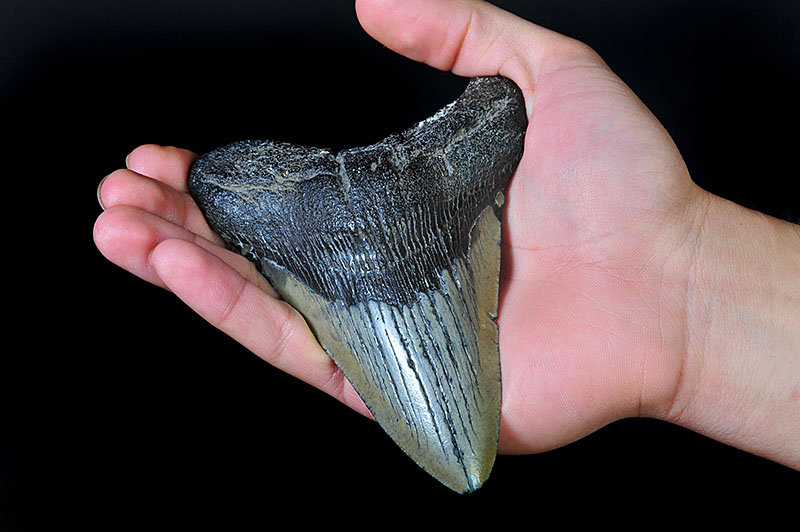
Dating fossils.
Through many decades of research, paleontologists have learned the order in which most kinds of fossils occur in the geological record. When a fossil species is first discovered, it usually occurs along with other species. If paleontologists know the position of the other species in the history of life, they can determine the position of the new species. This type of dating only indicates whether one fossil is older or younger than another. It does not provide a fossil’s age in years.
Paleontologists determine the age of a fossil by measuring radioactive isotopes in the rocks that contain the fossil. Radioactive isotopes are forms of chemical elements that break down, or decay, to form other materials. Scientists know the rates of decay for various such isotopes. By comparing the amount of a radioactive isotope in a rock to the amount of the material produced by its decay, scientists can calculate how long the decay has been taking place. This length of time represents the age of the rock and the fossils it contains.
